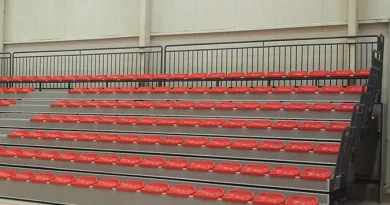Eco-Friendly Materials in Bleacher Design: A Sustainable Seating Solution
As the world becomes increasingly conscious of environmental impact, industries are shifting toward sustainable practices—and the bleacher industry is no exception. Whether you’re a school, venue, worship place, or gym owner, choosing eco-friendly materials for your bleachers can help reduce your carbon footprint while maintaining durability and functionality. In this blog post, we’ll explore the latest trends in eco-friendly bleacher design and how you can make a greener choice for your space.
Why Choose Eco-Friendly Bleachers?
Eco-friendly bleachers offer several benefits that go beyond just being good for the planet. Here’s why you should consider them:
- Environmental Impact: Traditional bleachers are often made from materials like steel and plastic, which require significant energy to produce and can contribute to pollution. Eco-friendly materials, on the other hand, are sourced sustainably and have a lower environmental footprint.
- Durability: Many sustainable materials are just as durable as traditional options, ensuring your bleachers last for years.
- Cost Savings: While some eco-friendly materials may have a higher upfront cost, their longevity and energy efficiency can lead to long-term savings.
- Positive Brand Image: Schools, venues, and worship places that prioritize sustainability can enhance their reputation and appeal to environmentally conscious communities.
Top Eco-Friendly Materials for Bleachers
1. Recycled Aluminum
- Why It’s Sustainable: Aluminum is 100% recyclable and requires significantly less energy to recycle than to produce from raw materials.
- Benefits:
- Lightweight and corrosion-resistant.
- Ideal for portable and telescopic bleachers.
- Long lifespan with minimal maintenance.
- Example Use: Many modern bleachers use recycled aluminum for frames and supports, reducing the need for virgin materials.
2. Reclaimed Wood
- Why It’s Sustainable: Reclaimed wood is sourced from old buildings, barns, or other structures, giving it a second life instead of ending up in landfills.
- Benefits:
- Adds a rustic, natural aesthetic to your space.
- Durable and resistant to wear when properly treated.
- Perfect for fixed bleachers in schools or worship places.
- Example Use: Some schools and churches use reclaimed wood bleachers to create a warm, inviting atmosphere.
3. Recycled Plastic
- Why It’s Sustainable: Recycled plastic is made from post-consumer waste, such as bottles and packaging, diverting it from landfills and oceans.
- Benefits:
- Weather-resistant and low-maintenance.
- Lightweight and easy to install.
- Available in a variety of colors and finishes.
- Example Use: Outdoor bleachers at parks and community centers often use recycled plastic for seats and decking.
4. Bamboo
- Why It’s Sustainable: Bamboo is a fast-growing, renewable resource that requires minimal water and no pesticides to grow.
- Benefits:
- Stronger than many traditional woods.
- Naturally resistant to pests and moisture.
- Adds a modern, eco-chic look to your space.
- Example Use: Bamboo is increasingly being used for bleacher seating in eco-friendly venues and gyms.
5. Composite Materials
- Why It’s Sustainable: Composites are often made from a mix of recycled wood fibers and plastics, combining the best of both materials.
- Benefits:
- Highly durable and resistant to rot, mold, and insects.
- Low maintenance and long-lasting.
- Can mimic the appearance of natural wood.
- Example Use: Composite materials are popular for outdoor bleachers in sports facilities and schools.
How to Choose the Right Eco-Friendly Bleachers
Selecting the right eco-friendly bleachers involves careful consideration of your needs and priorities. Here’s a step-by-step guide:
- Assess Your Needs: Consider the primary use of your bleachers (e.g., indoor vs. outdoor, fixed vs. portable) and determine the seating capacity and space requirements.
- Research Materials: Look for bleachers made from certified sustainable materials (e.g., FSC-certified wood, recycled content) and ask manufacturers about their sourcing and production practices.
- Evaluate Long-Term Benefits: While eco-friendly materials may have a higher upfront cost, consider their durability and maintenance requirements. Calculate potential energy savings and environmental benefits.
- Work with Reputable Suppliers: Choose manufacturers and suppliers with a proven track record in sustainable design. Request case studies or testimonials from previous clients.
Real-World Examples of Eco-Friendly Bleachers
Here are some inspiring examples of eco-friendly bleachers in action:
- Green School Initiative: A high school in California installed bleachers made from reclaimed wood and recycled aluminum, reducing their carbon footprint and inspiring students to embrace sustainability.
- Eco-Friendly Stadium: A sports venue in Oregon upgraded to bleachers made from recycled plastic and composite materials, earning recognition for their commitment to green practices.
- Sustainable Worship Space: A church in Texas chose bamboo bleachers for their community hall, creating a warm and eco-conscious environment for events.
The Future of Eco-Friendly Bleacher Design
As technology advances, we can expect even more innovative materials and designs in the bleacher industry. Some emerging trends include:
- Solar-Powered Bleachers: Integrated solar panels to power lighting and charging stations.
- Biodegradable Materials: Bleachers made from plant-based plastics or other biodegradable compounds.
- Modular Designs: Easily recyclable and reconfigurable bleachers to reduce waste.
Conclusion
Choosing eco-friendly materials for your bleachers is not just a trend—it’s a responsible decision that benefits the environment, your budget, and your community. Whether you’re upgrading a school gym, a sports venue, or a worship space, sustainable bleachers offer a practical and impactful solution.
Ready to make the switch? Explore our Product Guides and Buying Tips to find the perfect eco-friendly bleachers for your needs. Together, we can create a greener future, one seat at a time.

